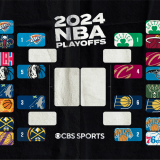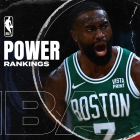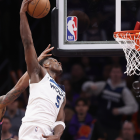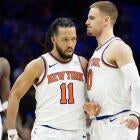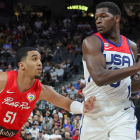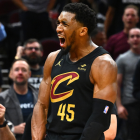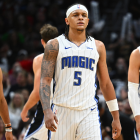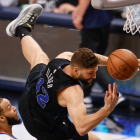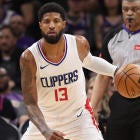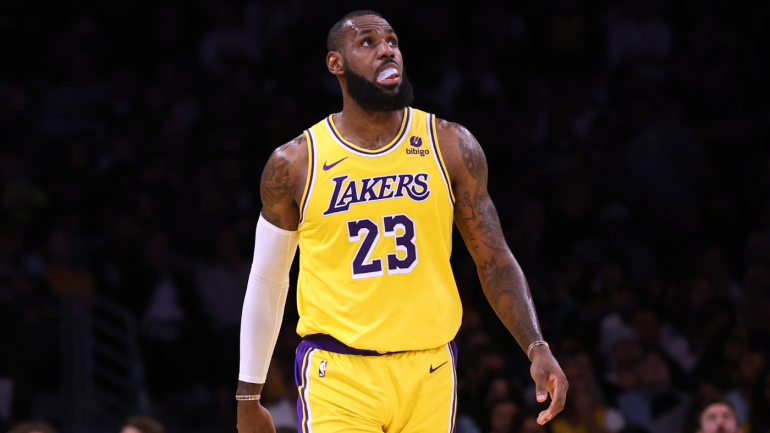
Lately, Los Angeles Lakers season previews needed to be extensive. Since LeBron James joined the team in 2018, he and Anthony Davis are the only players to spend more than three total seasons with the team. The roster has been turned over practically every offseason. Even last summer, when the offseason revolved around the decision not to trade Russell Westbrook, Rob Pelinka still managed to import seven new veterans. Speculation about how these teams would play was necessary because we'd never actually seen them.
That's not the case this time around. For the first time in the James era, the Lakers emphasized continuity. Yes, there are six new faces with guaranteed contracts, but most of those additions will either hold reserve roles or ride the bench for most of the season. The core of the group that reached the Western Conference Finals is still intact, and the Lakers are banking on improvement to come through internal development. We already know how most of these players fit together.
The questions therefore revolve around what lessons the Lakers took from last season and what roadblocks will simply be unavoidable. We have a pretty good idea of what the Lakers will look like this season, but these are the five questions that will determine whether this team falls short again or takes that final step back up to the top of the mountain.
1. Who starts and who closes?
Shocker: James and Davis are going to be starters. So will the recently re-signed Austin Reaves and D'Angelo Russell. Darvin Ham claims he's decided who is filling the last spot, but he won't reveal his answer until opening night. There are three viable candidates for the slot.
Taurean Prince has started in the preseason, but that hardly signifies anything given the league's laissez-faire approach to the exhibition season. Besides, Jarred Vanderbilt is hurt, and as the incumbent, he theoretically opened camp on the inside track. The numbers support his place in the first unit. The five-man unit of James, Davis, Reaves, Russell and Vanderbilt outscored opponents by 37 points in 77 regular-season minutes last spring, and before they ran into the Denver buzzsaw, that group was plus-20 in 151 playoff minutes as well.
But Rui Hachimura outplayed Vanderbilt in the postseason, and he's been LeBron's shadow throughout offseason workouts. If you believe in the role internal politics play in governing rosters, Hachimura got the heftier new contract this offseason, and The Athletic's Jovan Buha pegged him as the favorite to start when camp opened. Hachimura is the more well-rounded player. Vanderbilt is the more comfortable fit within this group of starters. Someone has to defend opposing ball-handlers, and Gabe Vincent would do a better job of covering up Hachimura's defensive shortcomings than Russell would. Why fix what isn't broken?
Of course, it was broken in the Nuggets series, and that takes us to a broader critique of the Laker offseason. For all of the praise they got for improving the bench, it doesn't seem as though the Lakers significantly improved their closing lineup. Maybe Vincent sneaks in ahead of Russell, but none of their offseason additions are automatic closers. They've gotten deeper—especially at the wing—but their best group is still at least one reliable two-way player short of matching Denver's. There's a possible solution here. We'll address it a bit later. The starter question will be answer soon. The closer question is going to evolve throughout the season.
2. Will Father Time gain any ground on LeBron?
The counting stats hid the very slight decline of LeBron James, but the tracking data paints a far more sobering picture of where exactly the 21-year-veteran stands at this moment. At the peak of his powers James averaged more than 13 drives per game. He was down to 9.7 a season ago. His isolation and pick-and-roll shot attempt numbers were far down from his apex as well, replaced by extra looks on spot-ups and in transition. These trends only grew starker in the playoffs.
James can still do most of the things he used to, but not as effectively or nearly as frequently. He picks his spots now, padding his counting stats with easier looks and only hitting the jets when the Lakers need it. That was his age-38 season. Where James is at this point in his career is without precedent, but logic dictates he'll likely be worse as a 39-year-old. We don't even know if he had surgery on the foot that hampered him throughout the postseason. At least 15 or 20 missed games seems inevitable.
The Lakers took steps to ease his burden. For all of his postseason flaws, Russell can keep the offense afloat for long stretches of the regular season. Part of what made last season's run possible was Reaves growing into the sort of shot-maker that could do the same, and Vincent is as steady as any backup point guard in the league, a far-cry from the roller coaster ride that was Dennis Schroder. James doesn't have to run dozens of pick-and-rolls every night anymore. Run the break, draw doubles in the post, steal a few points off cuts and let the kids run the show.
That will work from October through April. Get to May and June and things get harder. James doesn't need to outplay Nikola Jokic to beat him in a playoff series, but he needs to stay within his orbit. It wasn't close in Games 1-3 of the Western Conference Finals. The Nuggets had a tier 1 superstar and the Lakers did not. Game 4 proved that James can still summon that caliber of play. The Lakers need it more than once in a series. The goal for this season will be keeping James healthy enough to get there three or four times per series. If they do that, they can compete for a championship.
3. Big or small?
The Lakers are better with Anthony Davis at center than they are with him at power forward every year. Like clockwork. The net rating gap was so big in each of his first three Lakers seasons that Ham all but abandoned the power forward look last season, giving Davis just 29 total possessions at the position, according to Cleaning the Glass. But no matter how definitively center proves to be his better position, Davis just won't let go.
Davis made it clear to the Lakers that he wanted "more support at center" this offseason, according to ESPN's Dave McMenamin. Whether the Lakers actually play big or not, they're giving Davis significant bandwidth to play small. Ham wants him to shoot six 3's per game despite every shred of evidence suggesting he shouldn't. All signs are point to Davis spending less time near the basket next season.
Past iterations of the Lakers took steps to make Davis-at-power forward groups viable. Marc Gasol provided forward-caliber spacing with center-caliber rim-protection in 2021, for example, allowing Davis to function as a defensive power forward but an offensive center. Christian Wood meets the spacing requirement, but provides none of the ball-movement that made those Gasol lineups so special and is perhaps Gasol's polar opposite defensively. Jaxson Hayes theoretically matches the strengths of Dwight Howard and JaVale McGee in 2020, serving as an added layer of rim-protection that can also handle most of the rebounding and finish lobs in pick-and-roll. The trouble is that these skills are theoretical. Howard and McGee were established starting-caliber players. Hayes never has been. Maybe the Lakers can develop him and maybe he can't, but he comes without their pedigree.
Having the two of them provides valuable insurance for the games Davis misses, but when he's around, the data is going to continue to show that he should play without them. Do the Lakers heed those numbers? Or do they bow to Davis' preferences? Would doing so help keep him healthy? This is a matter of priority. If the Lakers want to maximize regular-season winning, they'll play Davis almost exclusively at center. Don't dismiss the thought. In a crowded Western Conference, a few wins could be the difference between home-court advantage and the play-in round. Are the Lakers willing to risk another perilous journey through the lower portion of the bracket if it means a better team once the postseason actually begins? This is just one of the minefields Ham is going to have to navigate.
4. Is there another diamond in the rough here?
The Lakers have been hit-or-miss on the bigger moves, but very few teams in basketball can claim a better recent record of uncovering diamonds in the rough. The 2020 Lakers don't win a championship without Alex Caruso hounding opposing ball-handlers. Reaves grew into the closest thing the James-Davis duo has ever had to a third star last season, and he did it as an undrafted free agent. The Lakers need these scouting successes. Acquiring high-end role players becomes much harder when you're paying two players max contracts and committed the bulk of your draft capital to acquiring them. If the Lakers don't develop these players, they don't get them.
They took a few swings on young players in free agency hoping to land another gem. Hayes will have a shot at minutes. Cam Reddish has a harder path, and he's never been a positive-value player at any of his three NBA stops. The talent is there for both former lottery picks. Both are likely hoping to go the Malik Monk route of parlaying a strong stint in the Lakers' developmental program into steadier work elsewhere.
The homegrown players are the ones worth watching for now. First-round pick Jalen Hood-Schifino has struggled in the preseason. Second-round pick Maxwell Lewis has not. He has prototypical forward size and a surprisingly crafty game near the rim. Like Reaves, he'll probably need to put on a little bit of weight before he can contribute steadily, and only time will tell how his jump shot translates to the NBA, but the early returns have been promising.
Max Christie is a year further down that timeline, and he was by far the best Laker at Summer League. He has better defensive tools than any Laker guard and looked good when given opportunities last season. He can shoot and defend, so he'll more than hold his own when he sees the floor this season, but his long-term upside lies with his own surprising shot-creating abilities. He's further ahead in that regard than you'd expect out of a second-year pro without much of a pre-draft pedigree, and the Lakers will give him chances to do what Reaves did a year ago. If he even comes close, the Lakers will have another winner on their hands.
5. Who's getting traded?
Here's a critical bit of CBA minutia: under the 2017 CBA, certain one-year contracts like the one D'Angelo Russell signed this summer came with an implicit no-trade clause. However, under the 2023 CBA, players and teams can agree to waive that no-trade clause upon signing. Russell and the Lakers did that. That means Russell will be tradable at the deadline when, in the past, he might not have been.
Does this matter? It's hard to say. The Lakers are talking a big game when it comes to continuity. They've also gone to great lengths to protect their future draft capital, refusing to deal multiple picks alongside Russell Westbrook last season when it seemed as though doing so would be necessary. But as we covered above, the Lakers made no significant upgrade to their closing five. With their season on the line, the Lakers will almost certainly turn to three of last year's players (James, Davis and Reaves) along with some combination of returning role players (Russell, Vanderbilt, Hachimura) and newcomers (Vincent, Prince) depending on the situation. If such groups couldn't beat Denver last season, why would they this season?
If the Lakers want to take a real swing at improvement within their best lineups, the path starts with Russell's $17.3 million salary and their unprotected 2029 first-round pick. That gets them in the door for impact players. Another salary (Vincent? Hachimura? Prince?) widens their pool of potentially acquirable upgrades. The search likely starts with two-way wings (Jerami Grant?) and secondary shot-makers (DeMar DeRozan? Zach LaVine?)
The name Kyrie Irving will come up if Dallas has a disappointing season. The Lakers can match money on him with Russell and Hachimura, just barely scraping below their self-imposed hard cap at the apron. Things would have to be hopeless for Dallas to consider such an offer. The last thing Luka Doncic wants is to start over with another overhauled roster. Other names will emerge as the season progresses. James Harden technically makes less than Irving, and his team seems far more motivated to move him.
The new CBA makes the Lakers heavy favorites for virtually any buyout target they seek. Any team above the first apron can no longer sign players on the buyout market if that player previously made at least the non-taxpayer mid-level exception. That immediately takes the Warriors, Clippers, Suns, Bucks, Celtics, Heat, Nuggets and 76ers out of the running for buyout players. The Lakers saved a roster spot for this exact purpose. They'll add at least one player in February. If they make a trade, it will be multiple.
Whether the changes or minimal or enormous, the Lakers will almost certainly end the season with a different roster than they begin it with. Right now, despite the bench improvements they've made, they simply do not have a five-man lineup that matches Denver's best. The season will dictate just how much more the Lakers need, but expect the rumors to start early and keep up through February's deadline. The Lakers don't have a championship team yet. They can certainly still build one.












